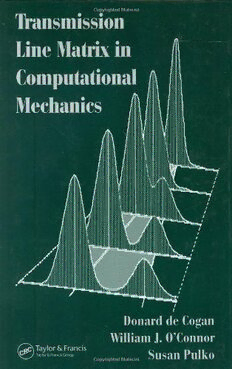Download Transmission Line Matrix (TLM) in Computational Mechanics PDF Free - Full Version
Download Transmission Line Matrix (TLM) in Computational Mechanics by Donard de Cogan, William J. O'Connor, Susan Pulko in PDF format completely FREE. No registration required, no payment needed. Get instant access to this valuable resource on PDFdrive.to!
About Transmission Line Matrix (TLM) in Computational Mechanics
The finite element method reigns as the dominant technique for modeling mechanical systems. Originally developed to model electromagnetic systems, the Transmission Line Matrix (TLM) method proves to match, and in some cases exceed, the effectiveness of finite elements for modeling several types of physical systems. Transmission Line Matrix in Computational Mechanics provides a tutorial approach to applying TLM for modeling mechanical and other physical systems.Transmission Line Matrix in Computational Mechanics begins with the history of TLM, an introduction to the theory using mechanical engineering concepts, and the electromagnetic basics of TLM. The authors then demonstrate the theory for use in acoustic propagation, along with examples of MATLAB® code. The remainder of the book explores the application of TLM to problems in mechanics, specifically heat and mass transfer, elastic solids, simple deformation models, hydraulic systems, and computational fluid dynamics. A discussion of state-of-the-art techniques concludes the book, offering a look at the current research undertaken by the authors and other leading experts to overcome the limitations of TLM in applying the method to diverse types of systems.This valuable reference introduces students, engineers, and researchers to a powerful, accurate, and stable alternative to finite elements, providing case studies and examples to reinforce the concepts and illustrate the applications.
Detailed Information
| Author: | Donard de Cogan, William J. O'Connor, Susan Pulko |
|---|---|
| Publication Year: | 2005 |
| ISBN: | 9780203022184 |
| Pages: | 275 |
| Language: | English |
| File Size: | 9.601 |
| Format: | |
| Price: | FREE |
Safe & Secure Download - No registration required
Why Choose PDFdrive for Your Free Transmission Line Matrix (TLM) in Computational Mechanics Download?
- 100% Free: No hidden fees or subscriptions required for one book every day.
- No Registration: Immediate access is available without creating accounts for one book every day.
- Safe and Secure: Clean downloads without malware or viruses
- Multiple Formats: PDF, MOBI, Mpub,... optimized for all devices
- Educational Resource: Supporting knowledge sharing and learning
Frequently Asked Questions
Is it really free to download Transmission Line Matrix (TLM) in Computational Mechanics PDF?
Yes, on https://PDFdrive.to you can download Transmission Line Matrix (TLM) in Computational Mechanics by Donard de Cogan, William J. O'Connor, Susan Pulko completely free. We don't require any payment, subscription, or registration to access this PDF file. For 3 books every day.
How can I read Transmission Line Matrix (TLM) in Computational Mechanics on my mobile device?
After downloading Transmission Line Matrix (TLM) in Computational Mechanics PDF, you can open it with any PDF reader app on your phone or tablet. We recommend using Adobe Acrobat Reader, Apple Books, or Google Play Books for the best reading experience.
Is this the full version of Transmission Line Matrix (TLM) in Computational Mechanics?
Yes, this is the complete PDF version of Transmission Line Matrix (TLM) in Computational Mechanics by Donard de Cogan, William J. O'Connor, Susan Pulko. You will be able to read the entire content as in the printed version without missing any pages.
Is it legal to download Transmission Line Matrix (TLM) in Computational Mechanics PDF for free?
https://PDFdrive.to provides links to free educational resources available online. We do not store any files on our servers. Please be aware of copyright laws in your country before downloading.
The materials shared are intended for research, educational, and personal use in accordance with fair use principles.

